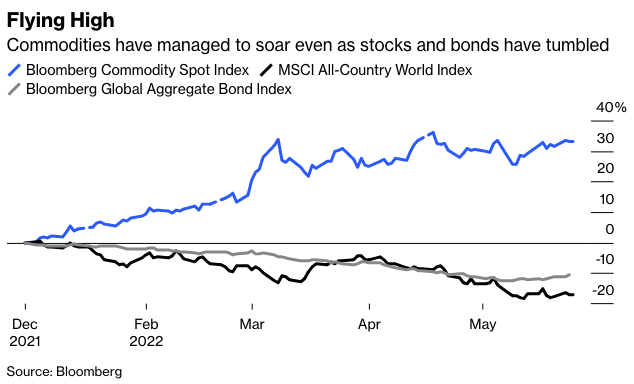Stocks have fallen to near-bear market territory. Bonds have suffered big price declines. Foreign currencies have nosedived against the U.S. dollar. Cryptocurrencies, SPACs and other speculations have collapsed. But commodities have been on a tear. The Bloomberg Commodity Spot Index has surged 33% this year, with energy, metals and agriculture prices all showing big gains.
Investors, spooked by faster inflation, rising geopolitical risks and accumulating portfolio losses, are pushing into commodity exchange-traded funds to hedge their portfolios. This year through April, $21.4 billion flowed into commodity ETFs in contrast to the $63 billion in outflows in the first four months of 2021, according to Morningstar. Commodities bulls may soon regret their enthusiasm as both demand and supply forces look like they will soon start to depress prices.

Covid-19 has led to continuing lockdowns in China, causing dramatic production cutbacks in the world’s second-largest economy, which accounts for 18.1% of global gross domestic product and 23.9% of manufacturing. The pain has spread to China’s imports of commodities from countries such as Brazil, Chile and Australia of oil, copper and iron ore as well as manufacturing exporters like Germany, South Korea and Taiwan. According to Nomura Holdings Inc., Chinese imports of iron were down 13% in April from a year earlier, copper fell 4% and imports of cars and chassis dropped 8%.
Russia’s invasion of Ukraine has also disrupted global demand and the robust dollar has curtailed demand for commodities by developing countries since their currencies have fallen 3% on average since April. Of 45 major commodities traded globally, 42 are priced in dollars. The only exceptions are wool (Australian dollars), amber (Russian rubles) and palm oil (Malaysian ringgit). Developing economy commodity imports are also depressed by their growing need to use scarce foreign exchange to service dollar-denominated debts. From 2018 through 2021, Chile’s non-bank dollar debt rose from 34.7% of GDP to 50.3%, Mexico’s from 21.9% to 30.1% and Turkey’s from 23.0% to 28.2%.
Commodities also suffer as economic growth favors services over goods. Since World War II, American spending on goods has dropped from 61% of their total outlays to 35% while spending for services rose from 38% to 65%. That’s also true for developing countries like China.
On the supply side, the wind continues to face commodity prices. Except for brief rises during wars and the 1970s oil embargoes, inflation-adjusted prices have fallen steadily since the mid-1800s, by a total of 83%. Substitutes and gains in productivity have always beaten threats of commodity shortages.
The devil is always in the details, but the prices of very different agricultural and industrial commodities often decline together since traders tend to be on the same side of the same commodity trades at the same time. For example, a speculator who is taking big losses in zinc positions is forced to sell wheat holdings to preserve capital—as are others.
Also, high prices are the best fertilizer for agricultural crops as well as other commodities. High grain prices induce farmers to plant fence-row to fence-row. But then, bumper harvests depress prices. Similarly, high pork prices induce sow breeding, especially if corn prices are low. Then excessive supplies of pigs depress the prices of pork chops. Even low prices can spur increased supply. Weak sugar prices encourage Brazilian farmers to plant and harvest more sugar cane to maintain their total income.
To be sure, watch out for non-economic forces. Bad weather can dissipate robust harvests of grains. Cartels can also promote disruptions. As a key example, actions by OPEC+ make forecasts of oil prices difficult. Also, U.S. frackers are not responding to high crude prices with more drilling. Instead, frackers are being encouraged by shareholders and their own compensation incentives to emphasize profitability. They’re being paid to keep costs down and retain cash to retire debt, pay dividends and buy back their stock.








